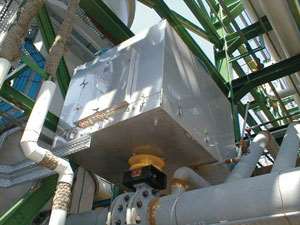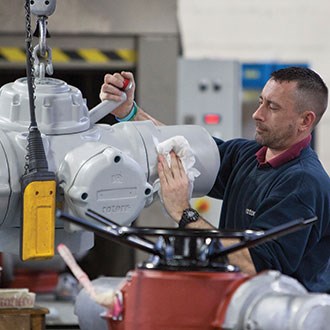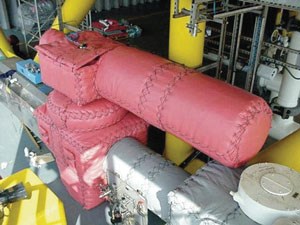Fire Protection Solutions
Because of the potential harm and damage to people and property, fires and explosions are a major concern in refinery, gas processing, petrochemical and offshore, and many other types of facilities.
#actuators
Fortunately, many actuator manufacturers and suppliers today have a range of fireproofing recommendations suitable for their actuators—from fixed passive protection to full fire retardant enclosures. These methods usually provide flexibility so they can be fitted to both new and existing actuators. The systems described in this article allow actuators to continue operating for a significant period of time in fire temperatures of over 1,800°F (982°C).
While this article’s scope is limited to actuators and gear boxes, it’s essential to note that valve top-works, cables, control entries and other components associated with potentially vulnerable systems must be properly protected as well.
The four main ways to protect valve actuators and gear boxes from fire are: flexible enclosures, semi-rigid enclosures, rigid enclosures and intumescent coating systems.
Flexible protective jacket enclosure systems offer a compact fireproofing solution for both actuator and related plant equipment. These systems are widely used, provide easy application and access, and can protect both the actuator and the valve.
Features and benefits associated with flexible fireproofing systems include:
- The jackets can be tailored to suit varying protection levels up to 2,100°F (1,149°C) for 30 minutes.
- They are easy to install requiring no special tools or training.
- The systems remain intact through the duration of the exposure to fire.
- They are easy to remove and re-install for inspections.
- They block the flame path and transfer heat.
- They can be repaired in the field.
- They are weatherproof and robust, but lightweight and cost effective.
- They can be designed to contain actuator, gear box and other plant equipment.
The design of these systems needs to be based upon the industry-approved graph of hydrocarbon fire versus temperature curve. The construction of these enclosures will vary with different actuators based on the actuator’s thermal mass, physical configuration and limiting surface temperatures.
A typical semi-rigid enclosure system consists of a steel sub-frame enclosed in a body of 8 pounds per cubic feet density silicate fiber blanket encapsulated to the inner (cold) face with 11.8 ounces per square yard (oz/yd2) glass cloth and to the outer (hot) face with 41.3 oz/yd2-weight wire-reinforced cloth. Both of these cloth elements should be coated with an elastomeric membrane to provide environmental protection. Alternatively, the enclosure may be tailored to fit directly onto the actuator body (see information in section on flexible enclosure systems).
The incorporation of special collars into the system accommodate the need for cable entries and penetrations for external declutch lever and handwheel operation, allowing full manual operation of the actuator without the need for removing any fire insulation.
Actuator surface temperature constraints vary in ranges of 158°F (70°C) to 662°F (350°C). Acceptable semi-rigid enclosure systems should be tested to UL1709 at a recognized research center to document that the enclosure can provide protection for the actuator for 30 minutes at up to 2,000°F (1093°C).
Besides these testing requirements, key considerations for semi-rigid enclosure systems are as follows:
- Individually tailored designs can minimize physical space requirements.
- They have low maintenance needs.
- A wide temperature constraint range exists.
- They can be frame-mounted or direct-mounted to the actuator.
- There should be easy access to key actuator features such as displays, control knobs and other features.
- They are durable and weather resistant.
- Temperature and time capabilities range widely.
- They can be designed to contain actuator, gearboxes and other plant equipment.
Rigid enclosure systems are easy to handle, yet robust enough to withstand the effects of repeated exposure to minor fires, often in a hostile environment that requires frequent in-service access.
The versatility of the rigid system enables a variety of material options to meet customer specifications. This ensures the design can accommodate difficulties in location and space restrictions. Special features can be incorporated to give direct access to the protected equipment even within these constraints.
Such enclosures are constructed using high thermal performance materials encapsulated within stainless-steel skins. Independent tests are carried out on these enclosures, verifying they pass industry standards.
Besides the testing, here are some key features and benefits:
- They can protect against flame temperatures in excess of 2,200°F (1,204°C).
- They can resist both blast and jet fires.
- Installation requires no special skills or tools.
- They can be retrofitted to existing units.
- They can provide up to 120 minutes of protection.
- They can withstand blast overpressure.
- Panels for inspection and maintenance are easily removable.
- They can be designed to contain actuator, gear box and other plant equipment.
Intumescent coating is effective in protecting against fire through basic thermodynamic principles and can provide superior protection and convenience. Without protection, a typical metal surface will reject about 20% of the heat of the fire. With an intumescent coating, 80–90% of the heat can be repelled. These coatings, provided by specialty manufacturers with proprietary formulations, are molded to the actuator.
When exposed to fire, the coating undergoes an endothermic reaction creating an expanded outer layer of lava-like char. The char layer has a very low thermal conductivity coefficient—the surface temperature of the char rises to within 100°F (38°C) of the fire. After the char layer is formed, the coating then remains passive, providing insulation and reflecting heat away from the actuator. Additionally, moisture is released during the process, drawing heat away from the layers below.
After a period of time, the heat penetration through the char reaches a level at which the coating material below is activated to form another char layer. This process is repeated several times as heat slowly penetrates and forms subsequent layers of char. These heat-transfer characteristics result in a very effective thermal barrier.
Considerations with intumescent coating include:
- They protect for more than 30 minutes in 2,000°F (1093°C) fires.
- The original actuator features are intact and accessible.
- They can exceed ANSI/API 607 and UL 1709.
- Minimal space is required.
- They provide fixed passive fire protection.
- They are permanently molded to the actuator and gear box.
- The coating is chemically inert.
- Operation and maintenance can occur without the need for special extensions or removal of panels, etc.
- Segmented coatings allow trouble-free dismantling and re-assembly of the actuator.
- There is minimal maintenance.
- They are durable and weatherproof.
Summary
As this article shows, there are several fire-protection options to consider for valve automation equipment. A good place to start in finding the best solution for a particular situation is to ask the manufacturer of the actuator. Don’t just choose a fire-protection method because it is used in other areas of the facility. Instead, talk to the manufacturer, do the homework and choose the best method for each specific application.
Mike Heuseveldt is marketing coordinator for Rotork Controls, Inc. (www.rotork.com). Reach him at info@rotork.com.
RELATED CONTENT
-
The Diverse Role Valves Play in the Chemical Industry
The chemical industry is extremely diverse with more than 60,000 known products. Like all process industries, the chemical industry needs valves designed for safe, efficient and reliable process operation.
-
The Actuators That Drive Subsea Operations
Subsea development includes different types of activities such as exploration, drilling, completion and production.Subsea manifolds are the arrangement of piping, valves, connections, structures and the foundation used in the subsea production system to receive, combine and distribute the hydrocarbon fluid
-
Grease for Motor Actuator Maintenance
Maintaining the right amount of grease inside motor actuators that use grease for lubrication is a vital part of valve maintenance, and can save time and money by preventing problems before they happen.














 Unloading large gate valve.jpg;maxWidth=214)